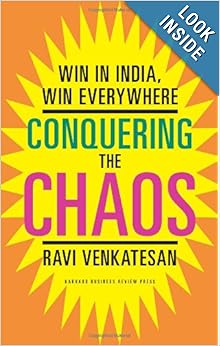This book is written by Ravi Venkatesan, Ex-CEO of Cummins India and Microsoft India. Ravi makes a case of why India is a great destination for multinational corporations (MNC) and associated challenges. According to Ravi, in spite of the well-known issues of poor infrastructure, bureaucracy, red-tape, corruption and land acquisition issues, India presents an excellent opportunity for MNC’s (even if Indian market contributes to less than 1% global revenue for the company). The author argues that there are more benefits than just low cost labor and low cost manufacturing (commonly termed as the offshoring) for setting up operations in India.
Several examples of world class companies like John Deere, Cummins, Nokia, Microsoft, Samsung and Unilever are included with case studies. One example stands out – John Deere and Mahindra. Mahindra has a majority of market share in India when it comes to low horse power tractors. Recently, Mahindra was also challenging John Deere in their strong foothold market in the some western countries by introducing low cost (but value) products. John Deere was losing on home front and also on foreign turf. For John Deere, all aspect from design to manufacturing to marketing were controlled from the headquarters. In the light of changed market conditions, John Deere decided to open a new facility in Pune, India for developing low power-low cost tractors. All aspects of the product development were managed form the Pune facility. The strategy paid off – John introduced a new tractor specifically tailored to the developing market like India. They were able to penetrate the market and claim a sizable market share. Additionally, they were able to launch modified version of these products on the home front to regain the lost share in the developed markets. Thus, by expanding in India and taking the competitors head-on, John Deere acquired essential skills and capabilities to innovate and develop tailored products.
For the India strategy to succeed, the author suggests a few tips:
- Instead of a strong headquarter control where every small policy and directive is issued, the author suggest to have some local autonomy for the Indian executives. Many MNCs control each and every aspect of business from the headquarter normally located in its parent country. The author argues that such a model is detrimental for India operations due to the differences in the cultures, business, political and social structures with respect to a typical western country. The strategies which work well in a developed western country do not necessarily apply in India.
- Many MNC try to standardize and use the “one size fit all” model. This might need some change – Indian customers are not necessary ready to pay premium prices for premium brands – A typical Indian customer will look at the value versus allied services and brand name. For example, the sachet size shampoos and conditioners packaging.
- The most important point which was highlighted in the book was – Use India as a testing ground for other developing countries. The author argues that skills a company will acquire as they work in India will be useful for other developing countries which ,might have even adverse conditions. If the company is successful is India, it can easily replicate the strategies in other developing countries, expanding their reach and market potential.
- Strategies to work with local politicians, corruption and red tape are interesting.
- Author’s views and suggestions of entering the Indian market with acquisition or joint venture with an Indian company are noteworthy.

No comments:
Post a Comment